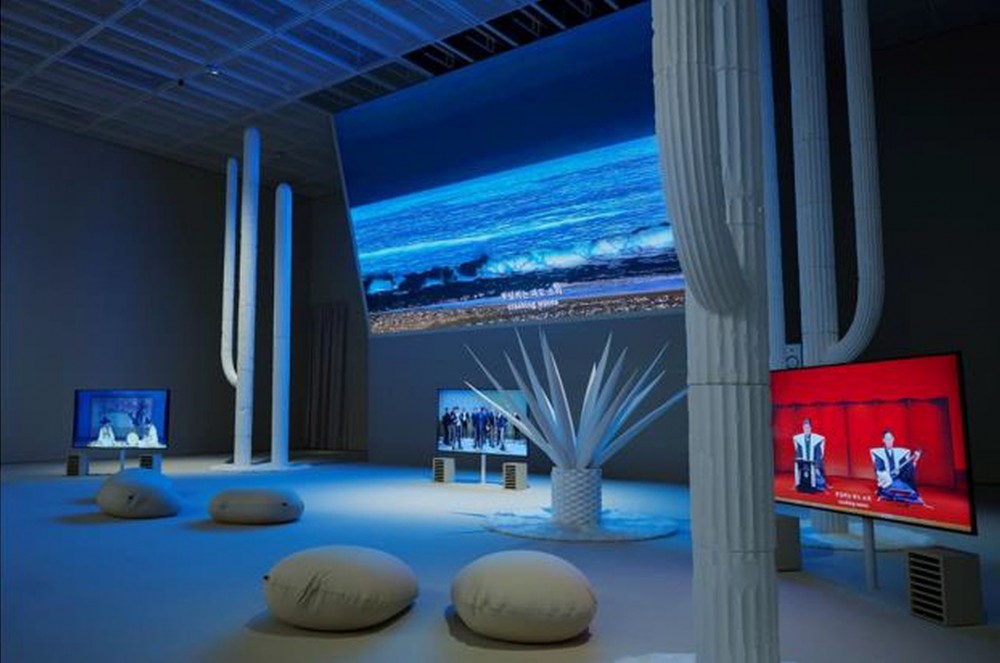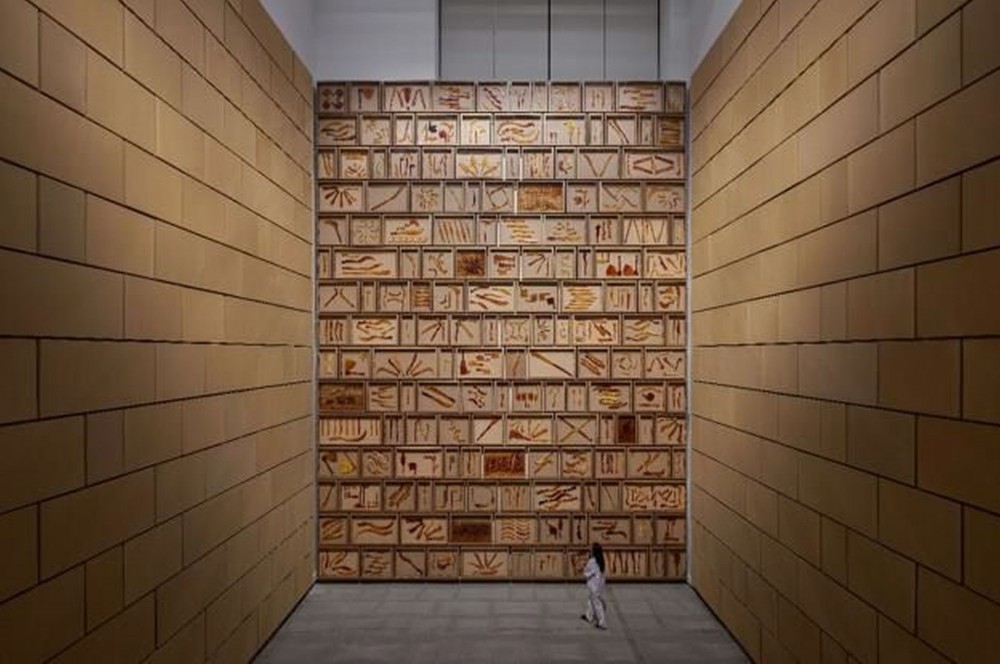Since 1998, artist Jung Yeondoo (b. 1969) has engaged the attention of both domestic and international art communities with his photographs, videos, and installations that are staged and performance-based. Adopting historical incidents and the stories of ordinary people as his subject matter, his works have raised questions about the paradoxical relationship between memories and representation, reality and imagery, and expansive narratives and individuals’. Since 2014, he has been showing an interest in documentary narratives and the inherent personal stories within them. Alongside of Here and Elsewhere (2015), which narrates the lives of immigrants in France, the artist has delved into modern Asian history in works like Classic and New (2018), A Girl in Tall Shoes (2018), Noise Quartet (2019), DMZ Theater (2021) and reconstructed grand narratives of war, disaster, migration, nation, and ideology, weaving them into personal narratives and myths. Moreover, Jung maintained a paradoxical perspective on reality, approaching it with fresh eyes and paying meticulous attention to unnoticed gaps and the multi-layered voices often overlooked in the process of organizing documentary narratives. This has been achieved through the interconnection of characters across different times and spaces or through the expression of ideas using the language of poetry, music, and theater.

▲ Installation view of One Hundred Years of Travels. Photograph by sonongji. © MMCA.
The narrative that Jung Yeondoo focuses on in MMCA Hyundai Motor Series 2023: Jung Yeondoo – One Hundred Years of Travels is that of the Korean diaspora to Mexico in the early 20th century. The “one hundred years of travels” in the title is a reference to the Korean migration that occurred over a century ago in 1905, when Koreans boarded the British merchant vessel SS Ilford at Incheon’s Jemulpo Harbor and traveled to Mérida, the capital city of the Mexican state of Yucatán. Jung’s interest in his century-old migration history originated with the mythology surrounding the travels of a particular plant: the prickly pear cactus. During a nine-month stay in Jeju Island to take part in a residency in 2022, the artist visited a colony of naturally growing prickly pears around Wollyeong, a village to the northwest of Jeju City. Hearing the story of the cactus’s journey and how its seeds had reportedly been carried over the Pacific Ocean from Mexico by the Kuroshio Current to set down roots on Jeju, Jung had the idea of focusing on the topic of a hundred years of travels by plants and people between Korea and Mexico. Here, a connection is drawn between the “transplantation” of the prickly pear cactus and the diaspora of Koreans uprooted to a different time and place. And, it becomes a channel opening up a third story beyond the existing migration narrative associated with imperialism, colonialism, labor, and history.
A total of five works by the artist are presented at MMCA Seoul’s Seoul Box and Gallery 5: four new artworks (One Hundred Years of Travels, Imaginary Song, Generational Portrait, and Wall of Blades) along with the 2022 work One Hundred Years of Travels – Prologue. This exhibition approaches the theme of ‘relocation and foreignness’ as a realm of possibility that connects seemingly unrelated beings transcending time and space. It also attempts to focus on the life experiences and voices of immigrants in a context of hybridity and diverse, intermingled cultures, using art to help viewers relate to unfamiliar people and things. Furthermore, the exhibition invites the viewer to think about the experience of temporal and special dislocation, the relationship between difference and familiarity, the cultural and historical generation gaps associated with migration, and the individuals who are translated across boundaries, beyond the documentary narrative of Korean migration in the early 20th century.
To approach the moments, experiences, and memories of early 20th-century immigrants as closely as possible, the artist paid three visits to Yucatán over a two-year period beginning in 2022, interviewing second-to fifth-generation descendants of Korean immigrants and taking photographs of various tropical plants at the state’s henequen farms, which were a crucial factor in bringing Koreans to Mexico. If the artist’s performative research approach of visiting actual historical locations represents a relational channel for extracting internal aspects of the Mexican diaspora narrative, his use of multiple media – most prominently including artistic staging, along with still photographs, videos, texts and sounds, performances, and installations – is a visual mechanism for bringing to the surface the hybridity contexts and the various ironies and contradictions concealed behind the fixed narrative of “diaspora history.” With their various mixtures (narrative/text/performance, performance/video), the artworks assume a pluralistic, complex quality that summons forth the migration narratives and sensations of movement in a more allegorical and layered way.
First, visitors encounter Imaginary Song (2023), a newly created sound installation presented at Seoul Box. Against the backdrop of eleven objects hanging from a ceiling where super-directional speakers have been installed, they hear the varied, polyphonous voices of people from different nationalities who are living in Korea as of 2023. In addition to allowing visitors to infer the unfamiliar sensations that Korean immigrants in Mexico would have experienced, this approach also encourages them to imagine a diverse world beyond that of a state constrained by homogeneity.
Presented at the entrance to Gallery 5, One Hundred Years of Travels – Prologue (2022) transforms the migration tale of the prickly pear cactus from Mexico to Jeju Island through Kuroshio Current into a hand-based performance by a mime artist, showing it through a video and a mixed media installation with a stage set, which are layered over the story of the Korean diaspora to Mexico in the early 20th century. The large four-channel video installation One Hundred Years of Travels (2023) is a key component of the exhibition, intercutting among performances based on texts related to the Mexican diaspora and rendered performances in 3-channel video, directed by the artist in three genres: Korean pansori, Japanese gidayu-bunraku, and Mexican mariachi. The installation includes a large LED screen with choreographic characteristics that edit images of farmers, labor, crowds, and plants together to synchronize with the musical rhythm from 3-channel performance videos. Simultaneously, the lights from the large LED screen bathe over the cactus-shaped objects and give layers to the space. Through the artist’s characteristically non-linear artistic approach transforming text-based narrative into performance, sound, video, image, cadence, rhythm, and light, the viewers revisit the Korean-Mexican diaspora narrative as a still-living zone of cultural production.

▲ Installation view of Wall of Blades. Photograph by sonongji. © MMCA.
Generational Portraits (2023) presents an intermediate state between still photograph and moving image through two large facing LED panels that show videos moving at a very slow pace. This work encourages viewers to imagine the relationships and generational gaps between parents and children descended from Korean immigrants. Finally, the 12-meter-tall wall installation Wall of Blades (2023) consists of objects shaped like farming implements (machetes) from around the world and made with the candied sugar sculpture techniques that evoke childhood memories. These have been assembled into an enormous wall inspired by the Wailing Wall in Israel, a country that provides the etymological origin for the term “diaspora.” The sense of sweetness conveyed by the sugar, the playfulness of shaping the candied sugar sculptures, and the visual sparkle conflict with the politics of sugar as a substance that inspired imperialism and diasporas. This ironic approach is an excellent representation of Jung’s objective: to represent history in an indirect and defamiliarizing way – and to thereby get closer to its essence.
Various associated programs have been organized for the exhibition period, including conversations, performances, and academic discussions. They include a discussion on diasporas with Professor emeritus Suh Kyung Sik from the Tokyo Keizai University Department of Contemporary Law, along with a performance at the gallery in October by performers of the pansori and gidayu-bushi styles featured in the new work One Hundred Years of Travels. Viewers can also examine Jung’s body of work in greater depth through a “Conversation with the Artist,” which is presented with the curator’s participation.
The first large-scale exhibition of Jung Yeondoo’s work at MMCA in 15 years, this event illustrates the transformations in his oeuvre over that time. It will also be an opportunity to encourage greater connections with diasporas, migrations, and movements that have become universal experiences in contemporary times.
■ MMCA Hyundai Motor Series (2014–2024)
Presented by MMCA and sponsored by Hyundai Motor, MMCA Hyundai Motor Series is an exhibition for which one established Korean artist (artist team) has been selected each year to receive support over a 10-year period since 2014. Past artists include Lee Bul in 2014, Ahn Kyuchul in 2015, Kimsooja in 2016, Im Heung Soon in 2017, CHOIJEONGHWA in 2018, Park Chan-kyong in 2019, Haegue Yang in 2020, the duo of MOON Kyungwon and JEON Joonho in 2021, and Choe U-Ram in 2022. The artist selected for 2023 is Jung Yeondoo.
The aims of MMCA Hyundai Motor Series are to broaden the horizons of Korean contemporary art while creating opportunities for enhancing the international stature of major Korean artists. Each year, it selects an established artist who has created their own distinctive body of work, providing support for creative activities and exhibition of their work along with active promotion in Korea and overseas. Viewers can experience the current state and dynamism of Korean contemporary art through work that reflects the selected artist’s distinctive attitude and sensibility.
MMCA Hyundai Motor Series has been described as a premier example of corporate support contributing greatly to the advancement of Korean art through the synergy that arises as culture and arts come together with the business world.
Organized by/Supported by
MMCA and Hyundai Motor Company
https://www.mmca.go.kr/eng/exhibitions/exhibitionsDetail.do?exhFlag=1

